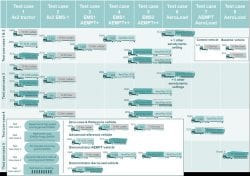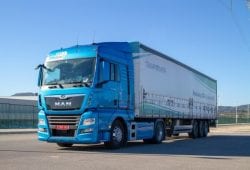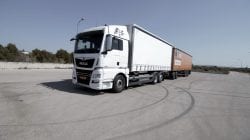Testing and assessing the impact of the AEROFLEX demonstrators
In 2020, the AEROFLEX demonstrator vehicles will be tested on the IDIADA test track and the public road in Spain. With the tests as input, TNO will assess the impact of the AEROFLEX vehicle configurations and innovations on transport efficiency in various customer-based situations. Before these exciting tasks will be carried out, a lot of preparations and reference tests are carried out. This newsletter article will give you a short overview of the progress of this work.
Testing does not start without a proper test plan. Since the vehicle configurations and innovations in AEROFLEX are far from standard, defining the test procedures and test matrix is far from standard as well. A lot of questions had to be answered in this process, such as: how to compare when different vehicles configurations such as EMS1 and EMS2 are used? How to validate the fuel consumption impact of a distributed powertrain using dolly and trailer in real life situations? How to measure the drag reduction using aerodynamic measures in combination with longer vehicles? How to test the impact in the logistical process in case of innovations which use the trailer space in a more optimal way? All these questions and many more are addressed in AEROFLEX deliverable 6.3, which is a guide for the reference tests, which already started. From this all we learned that not only new technologies are an innovation, but also the procedures how to test them.
The following picture shows the test matrix defined for the project:

In order to quantify the impact of the AEROFLEX demonstrator vehicles, reference tests with several vehicle configurations are needed. These tests started in February this year and will continue throughout 2019. The main purpose of these tests with both tractor-trailer combinations and EMS1 combinations is to set a standard for the fuel consumption impact of the upcoming demonstrator vehicles. In AEROFLEX, we use both the standard vehicle configurations as used today in several countries (tractor-trailer and EMS1) and the results of innovative projects such as TRANSFORMERS: the so-called advanced reference tests. With this, we wish to make sure to compare the AEROFLEX demonstrator vehicles not only with the vehicles of today, but also of tomorrow.
The test results of both reference vehicles as AEROFLEX demonstrator vehicles are input for the technical impact assessment. To define the impact, the AEROFLEX consortium decided to not only use test track data, but especially real life customer situations. For this, 8 specific and unique customer use cases were selected, detailed out and described in deliverable 6.1 in close cooperation with these logistic operators. In the second half of 2019, TNO started the work to define and build the assessment framework, needed to calculate the impact of the AEROFLEX vehicle configurations and innovations in these customer use cases. With this framework, the impact in a wide variety of real-life situations will be assessed when the first results of the demonstrator tests will be ready in 2020.
To conclude: WP6 in the AEROFLEX project already is in a very exciting phase and the best is yet to come: testing and assessing the demonstrators our AEROFLEX partners are working towards with great effort.
Àlex Freixas
Project Engineer, Powertrain, IDIADA








